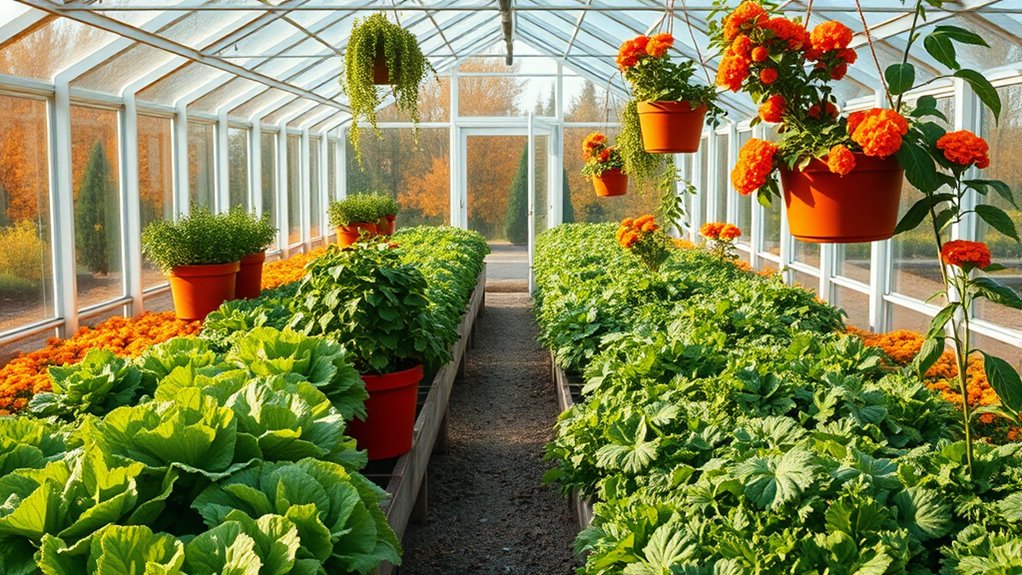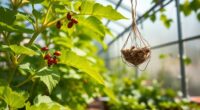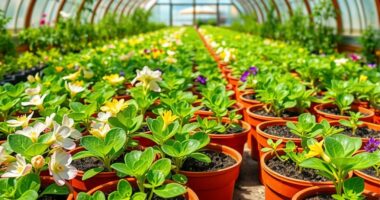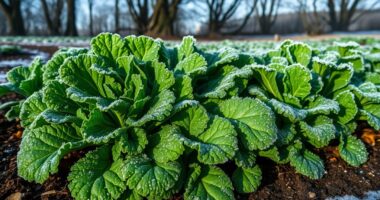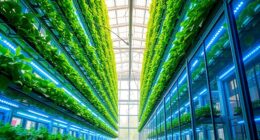To extend your harvest into autumn, focus on maintaining a stable, healthy environment inside your greenhouse. Manage humidity carefully to prevent mold and pests, and adjust your setup with shading or supplemental lighting to compensate for shorter days. Keep pests at bay through regular inspections and cleanups, preventing infestations that can ruin your crops. Proper temperature and moisture control will give your plants the right conditions to thrive all season. Discover more tips to maximize your fall gardening success.
Key Takeaways
- Use greenhouses to extend the growing season and harvest fresh produce into autumn.
- Implement regular pest inspections and organic treatments to prevent infestations indoors.
- Manage humidity with ventilation and dehumidifiers to avoid mold and maintain healthy plant growth.
- Adjust environmental conditions with shading, lighting, and insulation for stable temperatures.
- Keep the greenhouse clean and remove debris to reduce pest habitats and promote healthy plants.
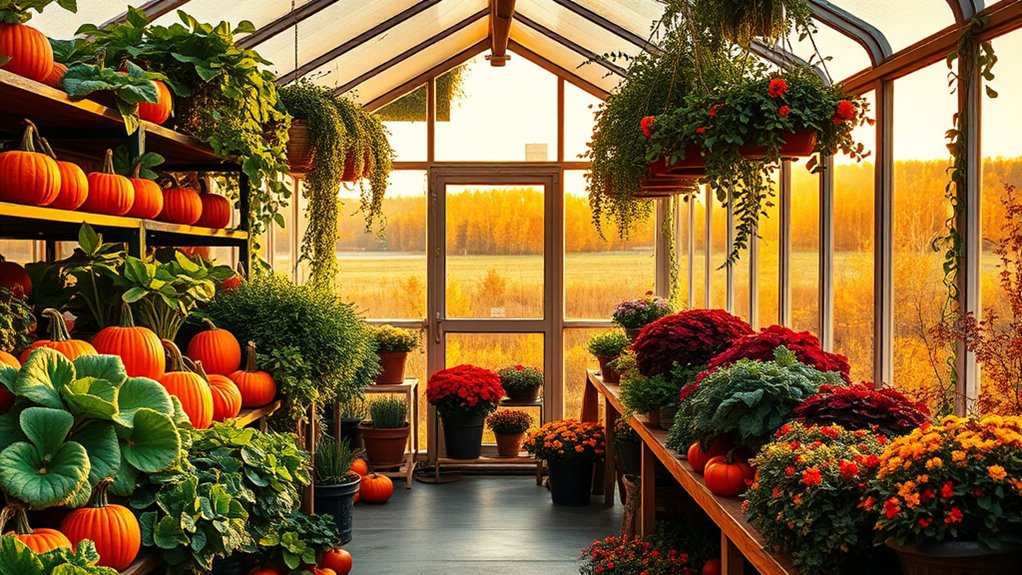
Have you considered extending your gardening season into fall? If so, you’re opening the door to a wealth of fresh produce and vibrant plants well beyond the typical summer harvest. As days grow shorter and temperatures drop outside, your greenhouse becomes a essential space to keep your garden thriving. To make the most of this extended season, you’ll need to focus on effective seasonal pest control and greenhouse humidity management. These two factors are indispensable for maintaining healthy plants and preventing common issues that can arise during fall.
Seasonal pest control becomes particularly important during fall because pests often seek shelter indoors as outdoor conditions become less hospitable. Regular inspections help you catch infestations early, preventing them from spreading or causing significant damage. You can use natural predators, organic sprays, or targeted treatments to keep pests at bay. It’s also necessary to maintain cleanliness inside your greenhouse—removing debris, fallen leaves, and dead plant material reduces hiding spots for pests. This proactive approach ensures your plants stay healthy and productive as you extend your harvest.
Greenhouse humidity management is another key component for successful fall gardening. As temperatures fluctuate, humidity levels can become problematic. Too much moisture creates an ideal environment for mold, mildew, and fungal diseases, which thrive in damp conditions. Conversely, overly dry air can stress your plants, leading to poor growth and increased vulnerability to pests. To strike the right balance, consider installing a hygrometer to monitor humidity levels closely. Using exhaust fans, dehumidifiers, or ventilation systems helps you control moisture, preventing condensation and promoting healthy plant development. Proper humidity management also helps reduce the risk of disease, keeping your plants in ideal condition throughout the fall.
Adjusting your greenhouse environment for fall isn’t just about temperature; it’s about creating a stable, healthy climate that supports your plants’ needs. Incorporate shading or supplemental lighting to compensate for shorter daylight hours, and consider insulating your greenhouse to maintain consistent temperatures. These steps, combined with vigilant pest control and humidity management, will help you sustain a thriving garden into autumn. Additionally, selecting preppy dog names that reflect the season can add a charming touch to your gardening experience. With careful attention, you can extend your harvest, enjoy fresh vegetables and herbs longer, and maximize your greenhouse’s productivity. Fall gardening inside a well-managed greenhouse isn’t just feasible—it’s an opportunity to enjoy gardening year-round, even as the seasons change. By staying proactive, you ensure your plants remain healthy, productive, and resilient throughout the cooler months ahead.
Frequently Asked Questions
What Are the Best Greenhouse Plants for Late Autumn?
For late autumn, you should focus on hardy varieties that thrive in cooler temperatures. These plants help with season extension, allowing you to enjoy fresh produce longer. Consider crops like kale, spinach, Swiss chard, and Brussels sprouts, which tolerate the chill. By choosing the right hardy varieties, you can keep your greenhouse productive well into the season, ensuring a steady harvest and fresh greens even as outdoor weather turns colder.
How Do I Prevent Pests in Autumn Greenhouse Gardening?
Your greenhouse can become a pest paradise, but you can stop it before it takes over. Use companion planting to naturally repel pests, pairing plants that deter insects with your crops. Incorporate natural repellents like neem oil or insecticidal soap to keep bugs at bay. Regularly inspect your plants, remove pests early, and keep your greenhouse clean. These steps will safeguard your harvest and help you enjoy a pest-free, thriving garden.
What Warming Techniques Are Most Effective for Fall Greenhouses?
To keep your greenhouse warm, you should focus on effective warming techniques like insulation methods and supplemental heating. Insulation methods, such as bubble wrap or thermal blankets, help retain heat, while supplemental heating options like electric or propane heaters provide consistent warmth during cold days. Using these techniques together guarantees your greenhouse stays warm enough to extend your growing season and shield your plants from autumn chills.
How Often Should I Water Plants During Autumn?
Oh, the mystery of watering frequency—sounds simple, right? In reality, soil moisture management is key. During autumn, you should water your plants when the top inch of soil feels dry, usually every 2-3 days. Don’t overdo it; too much water can lead to root rot, while too little stresses your plants. Keep a careful eye, and your plants will thank you all season long.
Can I Grow Tropical Plants in a Fall Greenhouse?
Yes, you can grow tropical plants in a fall greenhouse with proper tropical plant care. Make sure you maintain high humidity levels through greenhouse humidity control, which mimics their natural environment. Keep the temperature warm and avoid drafts. Regularly monitor moisture and provide adequate light, and your tropical plants will thrive even as seasons change, extending your gardening season into autumn.
Conclusion
By embracing fall greenhouse gardening, you can keep your harvest thriving well into autumn. With a little effort, you’ll enjoy fresh produce when others have already stopped. Remember, “The early bird catches the worm,” so start now to maximize your garden’s bounty. By extending your growing season, you turn your greenhouse into a year-round food source. Keep nurturing your plants, and you’ll reap the rewards long after summer’s gone.
